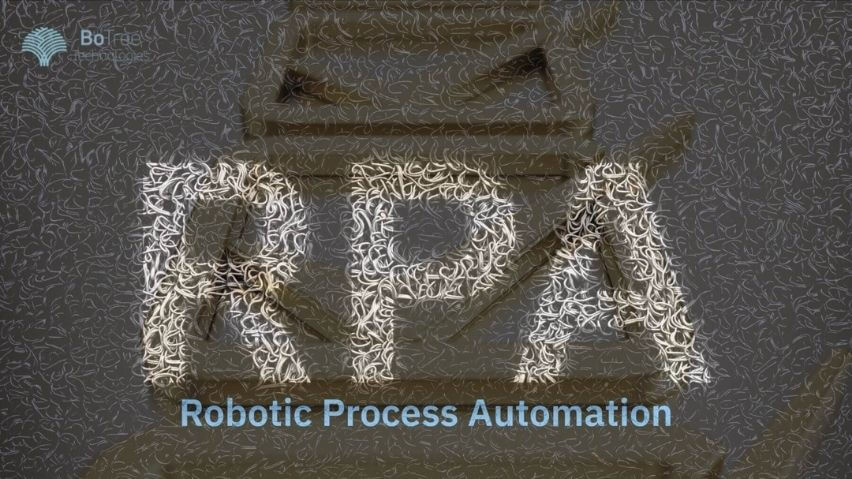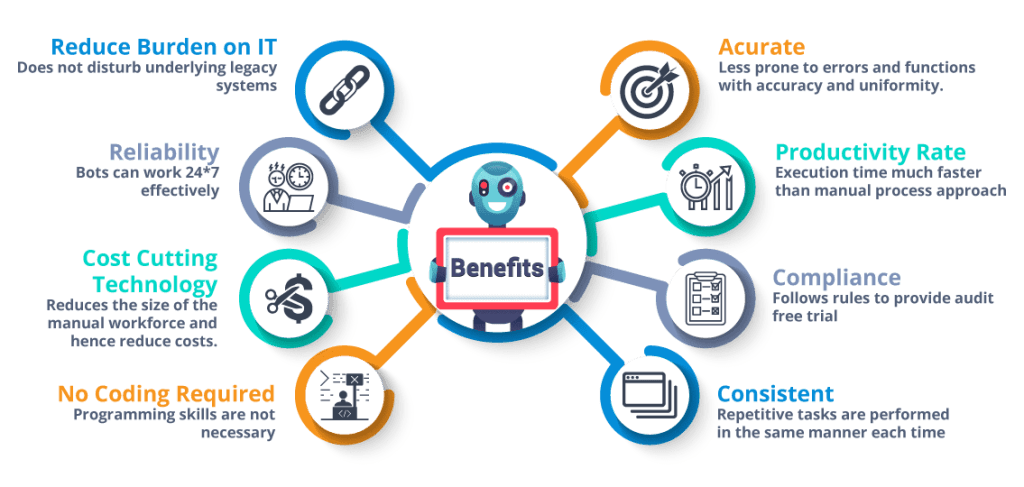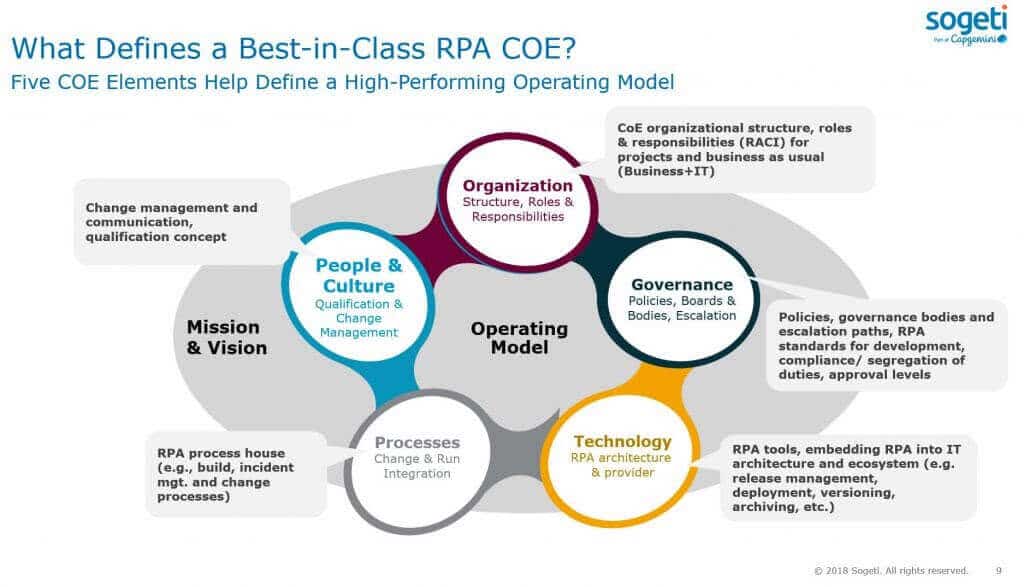
RPA checklist for Modern-day Enterprises
Automating rule-based and repetitive tasks can reduce the completion time by 50% – 80%. Robotic Process Automation is becoming a reality for organizations all over the world. Around 98% of IT leaders agree that RPA services implementation will lead to better business outcomes. In this article, we provide an RPA checklist that will assist you in implementing RPA the right way.
As a modern business, focusing on digital transformation is a priority. Following the conventional methods entails higher cost, no-growth in operational efficiencies and a traditional system of process execution – all of which seems outdated and doesn’t match the time’s businesses are operating in today.
RPA checklist: How it helps modern businesses
Before you look at the RPA process checklist, let’s understand how it will help your business. You would not want your business to spend a lot of time on mundane tasks. Being a progressive enterprise, your primary focus would be to inculcate innovation and bring a cultural shift that drives your business towards growth.
From businesses small to big, RPA methodology benefits every organization. Today, RPA implementation is growing at a rapid pace, and no statistics seem to say the true story.
However, there are several common areas where Robotic Process Automation(RPA) checklist is helping businesses drive maximum efficiency from their processes. The three primary operations include:-
- Invoice processing
Invoices have different formats and file structures. RPA bots extract data from all types of invoices and integrate into the accounting system for processing. The entire process of invoice automation involves a bot reading the invoice folder, gathering the invoice data and sending it to the appropriate system for the next step. - Report generation
Creating reports is a tedious task – one that takes away the creativity from an employee. RPA services utilize bots that can collect information from different sources and structure it in a presentable reporting format. These bots search for the information and dissect it into the format of your report. - Customer service
Robotic Process Automation implementation is highly effective in customer service. You can integrate bots to acquire the right information at the right time to serve the customers. It reduces the need to switch between applications for gathering information. RPA bots can also collect customer information by integration with forms and surveys.
Apart from these, RPA solutions are heavily impacting the analytics process, employee onboarding, payroll management, and information gathering. With the help of a single click, you can trigger a bot that will complete the desired action based on a set of rules.

Read these 11 extra essential use cases of RPA for businesses in different industries like healthcare, finance and many more.
Let’s move on to the RPA implementation steps phase and the RPA deployment checklist you need.
RPA checklist: questions to ask before implementation
More than 35% of RPA initiatives fail in just one year of implementation. While you may consider RPA solutions as a foolproof system for achieving efficiency, it only works where it is supposed to.
What this means is that automation is not for every process. If there are operations that are already working at maximum efficiency and there’s no need for RPA implementation, then you should skip it.
But more often than not, unrealistic expectations are also a significant issue with Robotic Process Automation solutions. Failing to meet these expectations, decision-makers deem RPA has an unsuccessful initiative.
You can save your RPA efforts from failure by asking a set of questions that will clear a million doubts before you implement. This RPA services checklist will also help you understand the scope of Robotic Process Automation solutions in your organization.
Question 1 – What part of the process should you automate?
While you can easily identify which processes need Robotic Process Automation services, the important thing is to recognize what part needs automation. Some functions need complete automation while for some, partial automation also works well.
For example, if you are automating a report generation process, would you achieve maximum efficiency and insights by automating data extraction or the complete process? Common sense says that creating the report requires human wisdom, which RPA cannot provide.
You need to identify whether the process has activities that are suitable for automation or not. The right tasks for RPA implementation will be repetitive, rule-based, have data inputs, have a sequence, and will validate data from multiple sources.
An essential aspect is to ask the benefit you will get from either full automation or partial automation. Commonly, RPA bots automate back-office operations and run 24×7 to maximize productivity.
Question 2 – Is your business ready for RPA implementation?
You may have decided that Robotic Process Automation is the way to go for your business. The biggest mistake is to see RPA as an IT aspect. It is more of a cultural change that will disrupt how your organization works today.
There are two things that your employees will be concerned about – First is that RPA will take over their job functions and leave them without any work. Second is what will happen if RPA does their job and they are forwarded to unknown job roles.
Adopting RPA is a management priority. You must ensure that your business is ready for RPA implementation steps. With RPA, you’ll have an additional capacity of employees who will have a responsibility to produce value-added outcomes through their new job roles.
You have to also oversee that there is a team to manage RPA bots at the operational level. Training a team to supervise the internal automation processes is crucial. It entails that you must first build internal capabilities for RPA services management before implementing it enterprise-wide.
This 7-step guide for RPA implementation will assist you in automating the right processes when you are ready for RPA.
Question 3 – Should you automate all the processes of your enterprise?
Needless to say, it is not possible to automate every activity. Around 45% of your processes are perfect for automation, several RPA studies showcase. While RPA solutions are not the answer to every problem, it will give your staff more time to come up with creative solutions for challenges.
Mostly, RPA is perfect for repetitive, rule-based, and mundane tasks that do not require much human intervention. It includes invoice automation, CRM automation, Excel automation, report automation, email automation, and web API automation.
The benefits of automation include a reduction in errors, faster completion of activities, and greater visibility of the actual work going on. RPA bots do not get tired, and that’s why organizations consider them to be the best workers for repetitive processes.
Automating 45% of your processes will generate additional capacity, which could be engaged in tasks that directly impact your business. It includes business development, marketing and resource planning, operations management, and more.
Question 4 – Is it the right time to integrate RPA services in your business?
This is an important question. You can never be sure of a challenge until you face it. For modern-day enterprises, efficiency is a big factor to stay ahead of the competition. Robotic Process Automation solutions are a necessity to keep that edge and stay relevant in the market.
If you have processes that are eating up a lot of valuable employee time, then automation should be a priority for you. While you cannot implement it all at once, rapid trials over a few weeks is a good method to test the waters for RPA.
You need to ensure if RPA is going to work for you or not. Through trials, you can learn and scale your RPA initiatives based on their performance. For digital transformation to be successful, RPA is a necessity for your business.
Accelerating the RPA implementation process requires pre-coded bots for quick integration with the existing system. They can provide faster results so that you can identify whether RPA will work for you or not in the long run.
Question 5 – How will you Develop Capabilities for RPA supervision?
One of the most significant aspects of RPA solutions implementation is understanding who will work with the technology. You need people who can manage the entire initiative, then someone who oversees the supervisors, and more supervisors for managing the processes.
You can either hire RPA developers from third-party vendors who are skilled in RPA tools like Automation Anywhere, UiPath, BluePrism and more. On the other hand, you can train your existing employees in RPA capabilities for continuous development.
The best approach is to create a dedicated centre of excellence that can work to develop and improve RPA skills within the organization. If you have resource constraints, you can move on to an RPA development company that can assist you completely with your RPA initiative.

You need to ensure that your internal capability development can justify the ROI. If the RPA initiatives fail, will the resources leave your organizations? And if not, how are you going to utilize their capabilities? These are vital aspects that you need to consider before implementation.
Conclusion: Follow the RPA Checklist for a clear Roadmap
Having a vague idea about your RPA initiatives is not a good idea. Your enterprise will tumble and fall. For proper implementation, you need to have a roadmap, which you obtain by answering the above questions. By following the above practical RPA checklist for automation, you will find the right path to take for RPA initiatives.
If you have no experience with RPA, the right thing to do is hire a third-party vendor or RPA company like BoTree Technologies that can implement the initiative enterprise-wide. You will get years of expertise in RPA and the right skills that will make your RPA services implementation a successful strategy.




